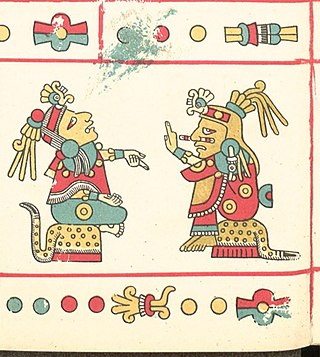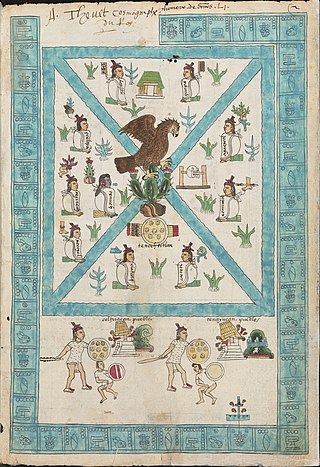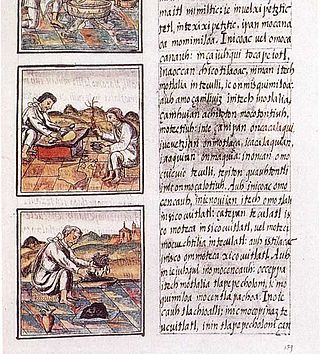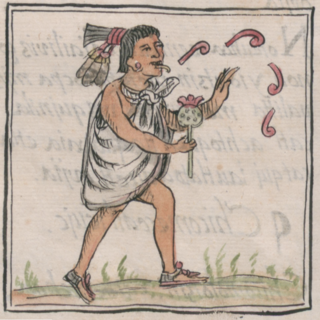Related Research Articles

Our Lady of Guadalupe, also known as the Virgin of Guadalupe, is a Catholic title of Mary, mother of Jesus associated with a series of four Marian apparitions to a Mexican peasant named Juan Diego and one to his uncle, Juan Bernardino, which are believed to have occurred in December 1531, when the Mexican territories were part of the Spanish Empire.

In Aztec mythology, Tonacatecuhtli was a creator and fertility god, worshipped for populating the earth and making it fruitful. Most Colonial-era manuscripts equate him with Ōmetēcuhtli. His consort was Tonacacihuatl.

Ōmeteōtl is a name used to refer to the pair of Aztec deities Ometecuhtli and Omecihuatl, also known as Tōnacātēcuhtli and Tonacacihuatl. Ōme translates as "two" or "dual" in Nahuatl and teōtl translates as "phenomena". The existence of such a concept and its significance is a matter of dispute among scholars of Mesoamerican religion. Ometeotl was one as the first divinity, and Ometecuhtli and Omecihuatl when the being became two to be able to reproduce all creation.

In Aztec mythology, Tōnacācihuātl was a creator and goddess of fertility, worshiped for peopling the earth and making it fruitful. Most Colonial-era manuscripts equate her with Ōmecihuātl. Tōnacācihuātl was the consort of Tōnacātēcuhtli. She is also referred to as Ilhuicacihuātl or "Heavenly Lady."

Bernardino de Sahagún was a Franciscan friar, missionary priest and pioneering ethnographer who participated in the Catholic evangelization of colonial New Spain. Born in Sahagún, Spain, in 1499, he journeyed to New Spain in 1529. He learned Nahuatl and spent more than 50 years in the study of Aztec beliefs, culture and history. Though he was primarily devoted to his missionary task, his extraordinary work documenting indigenous worldview and culture has earned him the title as “the first anthropologist." He also contributed to the description of Nahuatl, the imperial language of the Aztec Empire. He translated the Psalms, the Gospels, and a catechism into Nahuatl.

Miguel León-Portilla was a Mexican anthropologist and historian, specializing in Aztec culture and literature of the pre-Columbian and colonial eras. Many of his works were translated to English and he was a well-recognized scholar internationally. In 2013, the Library of Congress of the United States bestowed on him the Living Legend Award.

Aztec codices are Mesoamerican manuscripts made by the pre-Columbian Aztec, and their Nahuatl-speaking descendants during the colonial period in Mexico.

The Florentine Codex is a 16th-century ethnographic research study in Mesoamerica by the Spanish Franciscan friar Bernardino de Sahagún. Sahagún originally titled it La Historia General de las Cosas de Nueva España. After a translation mistake, it was given the name Historia general de las Cosas de Nueva España. The best-preserved manuscript is commonly referred to as the Florentine Codex, as the codex is held in the Laurentian Library of Florence, Italy.

Alonso de Molina was a Franciscan priest and grammarian, who wrote a well-known dictionary of the Nahuatl language published in 1571 and still used by scholars working on Nahuatl texts in the tradition of the New Philology. He also wrote a bilingual confessional manual for priests who served in Nahuatl-speaking communities.

The Colegio de Santa Cruz in Tlatelolco, Mexico City, is the first and oldest European school of higher learning in the Americas and the first major school of interpreters and translators in the New World. It was established by the Franciscans on January 6, 1536 with the intention, as is generally accepted, of preparing Native American boys for eventual ordination to the Catholic priesthood. Students trained in the Colegio were important contributors to the work of Franciscan Bernardino de Sahagún in the creation of his monumental twelve-volume General History of the Things of New Spain, often referred to as the Florentine Codex. The failure of the Colegio had long-lasting consequences, with scholar Robert Ricard saying that "[h]ad the College of Tlatelolco given the country even one [native] bishop, the history of the Mexican Church might have been profoundly changed."
Fray Gerónimo de Mendieta (1525–1604), alternatively Jerónimo de Mendieta, was a Franciscan missionary and historian, who spent most of his life in the Spanish Empire's new possessions in Mexico and Central America.
The Exercicio quotidiano is a Nahuatl-language Christian religious manuscript, consisting of daily meditations with Latin passages taken from the New Testament.
The Primeros Memoriales is an illustrated Nahuatl-language manuscript compiled by the Franciscan missionary Bernardino de Sahagún and his indigenous assistants in Tepepulco as the first part of his project to document pre-Columbian Nahua society, known as the Historia General de las Cosas de Nueva España.

Antonio Valeriano was a colonial Mexican, Nahua scholar and politician. He was a collaborator with fray Bernardino de Sahagún in the creation of the twelve-volume General History of the Things of New Spain, the Florentine Codex, He served as judge-governor of both his home, Azcapotzalco, and of Tenochtitlan, in Spanish colonial New Spain.
New Philology generally refers to a branch of Mexican ethnohistory and philology that uses colonial-era native language texts written by Indians to construct history from the indigenous point of view. The name New Philology was coined by James Lockhart to describe work that he and his doctoral students and scholarly collaborators in history, anthropology, and linguistics had pursued since the mid-1970s. Lockhart published a great many essays elaborating on the concept and content of the New Philology and Matthew Restall published a description of it in the Latin American Research Review.
Frances Esther Karttunen, also known as Frances Ruley Karttunen, is an American academic linguist, historian and author.

Nahuatl, Aztec, or Mexicano is a language or, by some definitions, a group of languages of the Uto-Aztecan language family. Varieties of Nahuatl are spoken by about 1.7 million Nahuas, most of whom live mainly in Central Mexico and have smaller populations in the United States.
A Nahuatl name is a given name in the Nahuatl language that was used by the Aztecs.
Omeyocan is the highest of thirteen heavens in Aztec mythology, the dwelling place of Ometeotl, the dual god comprising Ometecuhtli and Omecihuatl.

Jose Jorge Klor de Alva, is a Mexican-born anthropologist, the president of Nexus Research and Policy Center, an independent research and policy advocacy organization for the improvement of college education of nontraditional and underserved students. He is also chairman of 3DMX, Inc., a technology company in Silicon Valley that focuses, through its Mexico-based University of Advanced Technologies, on education and training programs in digital and advanced manufacturing technologies. He was previously the Class of 1940 Professor at UC-Berkeley and Professor of Anthropology at Princeton University.
References
- ↑ "H-LatAm | H-Net". Networks.h-net.org. Retrieved 5 March 2022.
- ↑ "H-Nahuatl | H-Net". Networks.h-net.org.
- ↑ "John F. Schwaller '69, Doctor of Humane Letters | Grinnell College". Grinnell.edu.
- ↑ "SUNY Potsdam President and son to receive degrees at Grinnell ceremony | SUNY Potsdam". Archived from the original on 2018-05-19. Retrieved 2018-05-18.